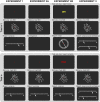Serial dependence in the perception of visual variance
- PMID: 29971350
- PMCID: PMC6028984
- DOI: 10.1167/18.7.4
Serial dependence in the perception of visual variance
Abstract
The recent history of perceptual experience has been shown to influence subsequent perception. Classically, this dependence on perceptual history has been examined in sensory-adaptation paradigms, wherein prolonged exposure to a particular stimulus (e.g., a vertically oriented grating) produces changes in perception of subsequently presented stimuli (e.g., the tilt aftereffect). More recently, several studies have investigated the influence of shorter perceptual exposure with effects, referred to as serial dependence, being described for a variety of low- and high-level perceptual dimensions. In this study, we examined serial dependence in the processing of dispersion statistics, namely variance-a key descriptor of the environment and indicative of the precision and reliability of ensemble representations. We found two opposite serial dependences operating at different timescales, and likely originating at different processing levels: A positive, Bayesian-like bias was driven by the most recent exposures, dependent on feature-specific decision making and appearing only when high confidence was placed in that decision; and a longer lasting negative bias-akin to an adaptation aftereffect-becoming manifest as the positive bias declined. Both effects were independent of spatial presentation location and the similarity of other close traits, such as mean direction of the visual variance stimulus. These findings suggest that visual variance processing occurs in high-level areas but is also subject to a combination of multilevel mechanisms balancing perceptual stability and sensitivity, as with many different perceptual dimensions.
Figures





Similar articles
-
Serial Dependence in Perceptual Decisions Is Reflected in Activity Patterns in Primary Visual Cortex.J Neurosci. 2016 Jun 8;36(23):6186-92. doi: 10.1523/JNEUROSCI.4390-15.2016. J Neurosci. 2016. PMID: 27277797 Free PMC article.
-
Opposite Effects of Recent History on Perception and Decision.Curr Biol. 2017 Feb 20;27(4):590-595. doi: 10.1016/j.cub.2017.01.006. Epub 2017 Feb 2. Curr Biol. 2017. PMID: 28162897
-
Adaptation to mean and variance: Interrelationships between mean and variance representations in orientation perception.Vision Res. 2020 Feb;167:46-53. doi: 10.1016/j.visres.2020.01.002. Epub 2020 Jan 16. Vision Res. 2020. PMID: 31954877
-
Serial Dependence in Perception.Annu Rev Psychol. 2024 Jan 18;75:129-154. doi: 10.1146/annurev-psych-021523-104939. Epub 2023 Sep 27. Annu Rev Psychol. 2024. PMID: 37758238 Review.
-
Serial dependence in visual perception: A meta-analysis and review.J Vis. 2023 Aug 1;23(8):18. doi: 10.1167/jov.23.8.18. J Vis. 2023. PMID: 37642639 Free PMC article. Review.
Cited by
-
Time-consciousness in computational phenomenology: a temporal analysis of active inference.Neurosci Conscious. 2023 Mar 17;2023(1):niad004. doi: 10.1093/nc/niad004. eCollection 2023. Neurosci Conscious. 2023. PMID: 36937108 Free PMC article.
-
You see what you look for: Targets and distractors in visual search can cause opposing serial dependencies.J Vis. 2021 Sep 1;21(10):3. doi: 10.1167/jov.21.10.3. J Vis. 2021. PMID: 34468704 Free PMC article.
-
Brief Stimuli Cast a Persistent Long-Term Trace in Visual Cortex.J Neurosci. 2022 Mar 9;42(10):1999-2010. doi: 10.1523/JNEUROSCI.1350-21.2021. Epub 2022 Jan 21. J Neurosci. 2022. PMID: 35064003 Free PMC article.
-
The functional role of serial dependence.Proc Biol Sci. 2018 Oct 31;285(1890):20181722. doi: 10.1098/rspb.2018.1722. Proc Biol Sci. 2018. PMID: 30381379 Free PMC article.
-
Opposing serial effects of stimulus and choice in speech perception scale with context variability.iScience. 2024 Jul 30;27(9):110611. doi: 10.1016/j.isci.2024.110611. eCollection 2024 Sep 20. iScience. 2024. PMID: 39252961 Free PMC article.
References
-
- Alais, D., Ho, T., Han, S.. (2017). A matched comparison across three different sensory pairs of cross-modal temporal recalibration from sustained and transient adaptation. i-Perception, 8 4, 1– 18, https://doi.org/10.1177/2041669517718697. - DOI - PMC - PubMed
-
- Albrecht, A. R., Scholl, B. J.. (2010). Perceptually averaging in a continuous visual world: Extracting statistical summary representations over time. Psychological Science, 21 4, 560– 567, https://doi.org/10.1177/0956797610363543. - DOI - PubMed
-
- Alvarez, G. A. (2011). Representing multiple objects as an ensemble enhances visual cognition. Trends in Cognitive Sciences, 15 3, 122– 131, https://doi.org/10.1016/j.tics.2011.01.003. - DOI - PubMed
-
- Alvarez, G. A., Oliva, A.. (2009). Spatial ensemble statistics are efficient codes that can be represented with reduced attention. Proceedings of the National Academy of Sciences, USA, 106 18, 7345– 7350, https://doi.org/10.1073/pnas.0808981106. - DOI - PMC - PubMed
-
- Ariely, D. (2001). Seeing sets: Representation by statistical properties. Psychological Science, 12 2, 157– 162. - PubMed
Publication types
MeSH terms
Grants and funding
LinkOut - more resources
Full Text Sources
Other Literature Sources

